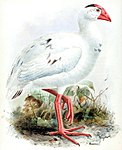Vit purpurhöna
| Vit purpurhöna Status i världen: Utdöd [1] | |
 | |
| Systematik | |
|---|---|
| Domän | Eukaryoter Eukaryota |
| Rike | Djur Animalia |
| Stam | Ryggsträngsdjur Chordata |
| Understam | Ryggradsdjur Vertebrata |
| Klass | Fåglar Aves |
| Ordning | Tran- och rallfåglar Gruiformes |
| Familj | Rallar Rallidae |
| Släkte | Porphyrio |
| Art | Vit purpurhöna P. albus |
| Vetenskapligt namn | |
| § † Porphyrio albus | |
| Auktor | (Shaw, 1790) |
Vit purpurhöna[2] (Porphyrio albus) är en utdöd fågel i familjen rallar inom ordningen tran- och rallfåglar.[3] Den förekom tidigare på Lord Howeön. Fågeln rapporterades senast 1834.[3] IUCN kategoriserar arten som utdöd.[1]
Noter
- ^ [a b] Birdlife International 2012 Porphyrio albus Från: IUCN 2015. IUCN Red List of Threatened Species. Version 2015.4 www.iucnredlist.org. Läst 1 februari 2016.
- ^ Sveriges ornitologiska förening (2016) Officiella listan över svenska namn på världens fågelarter Arkiverad 18 oktober 2014 hämtat från the Wayback Machine., läst 2016-10-10
- ^ [a b] Clements, J. F., T. S. Schulenberg, M. J. Iliff, D. Roberson, T. A. Fredericks, B. L. Sullivan, and C. L. Wood (2016) The eBird/Clements checklist of birds of the world: Version 2016 http://www.birds.cornell.edu/clementschecklist/download, läst 2016-08-11
Externa länkar
 Wikimedia Commons har media som rör vit purpurhöna.
Wikimedia Commons har media som rör vit purpurhöna. Wikispecies har information om Porphyrio albus.
Wikispecies har information om Porphyrio albus.
Media som används på denna webbplats
Gemälde mit einem Lord-How-Purpurhuhn (Porphyrio albus)
The Lord Howe Swamphen or White Gallinule, Porphyrio albus, was a large bird in the family Rallidae endemic to Lord Howe Island, Australia.
Holotype of Porphyrio stanleyi, a synonym of Porphyrio alba, one of two specimens in existence.
Lord Howe Purpurhuhn (Porphyrio albus) from Journal of a Voyage to New South Wales. 1790
Representation of a Bird of the Coot kind (Porphyrio albus), found at Lord Howe Island in the south sea. From drawings from his journal. `A Journal of a Voyage from Portsmouth to New South Wales and China in the Lady Penrhyn ...', 1787-1789. By Arthur Bowes Smyth.








